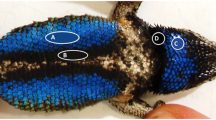Summary
Intrasexual conflict and mating behavior were observed in a population of thirteen-lined ground squirrels (Spermophilus tridecemlineatus). Success in male-male competition was related strongly to male weight, whereas both the weight and age of males were correlated positively with estimated mating success.
Between-season fluctuations in the density of reproductive males were analyzed in terms of their effects on the population's operational sex ratio (OSR). Changes in the OSR corresponded with changes in behavioral aspects of sexual selection: when the OSR became less male-biased, intrasexual confliet was reduced, sexual interference declined, and males essentially had unrestricted access to estrous females. Opportunities for female choice likewise became limited as estrous females rarely were approached by more than one male.
Similar content being viewed by others
References
Alcock J (1980) Natural selection and the mating systems of solitary bees. Am Sci 68:146–153
Berven K (1981) Mate choice in the wood frog, Rana sylvaticus. Evolution 35:707–722
Borgia G (1979) Sexual selection and the evolution of mating systems. In: Blum M, Blum N (eds) Sexual selection and reproductive competition in insects. Academic Press, New York, pp 19–80
Clutton-Brock T, Albon S, Gibson R, Guinness F (1979) The logical stag: Adative aspects of fighting in red deer (Cervus elaphus L.). Anim Behav 27:211–225
Emlen S, Oring L (1977) Ecology, sexual selection and the evolution of mating systems. Science 198:215–233
Foster M (1934) The reproductive cycle in the female ground squirrel, Citellus tridecemlineatus (Mitchell). Am J Anat 54:487–511
Howard R (1981) Male age-size distribution and male mating success in bullfrogs. In: Alexander R, Tinkle D (eds) Natural selection and social behavior. Chiron Press, New York, pp 61–77
McCarley H (1966) Annual cycle, population dynamics and adaptive behavior of Citellus tridecemlineatus. J Mammal 47:294–316
McCauley D (1982) The behavioural components of sexual selection in the milkweed beetle Tetraopes tetraophthalmus. Anim Behav 30:23–28
Schwagmeyer P (1979) The function of alarm calling behavior in Spermophilus tridecemlineatus, the thirteen-lined ground squirrel. PhD thesis, University of Michigan, Ann Arbor
Schwagmeyer P (in press) Multiple mating and intersexual selection in the thirteen-lined ground squirrel. In: Michener G, Murie J (eds) Biology of ground-dwelling squirrels: Annual cycles, behavioral ecology, and sociality. University of Nebraska Press, Lincoln
Thornhill R (1981) Panorpa (Mecoptera: Panorpidae) scorpionflies: Systems for understanding resource-defense polygyny and alternative male reproductive efforts. Annu Rev Ecol Syst 12:355–386
Wells K (1977) The social behaviour of anuran amphibians. Anim Behav 25:666–693
Author information
Authors and Affiliations
Rights and permissions
About this article
Cite this article
Schwagmeyer, P.L., Brown, C.H. Factors affecting male-male competition in thirteen-lined ground squirrels. Behav Ecol Sociobiol 13, 1–6 (1983). https://doi.org/10.1007/BF00295069
Received:
Accepted:
Issue Date:
DOI: https://doi.org/10.1007/BF00295069




